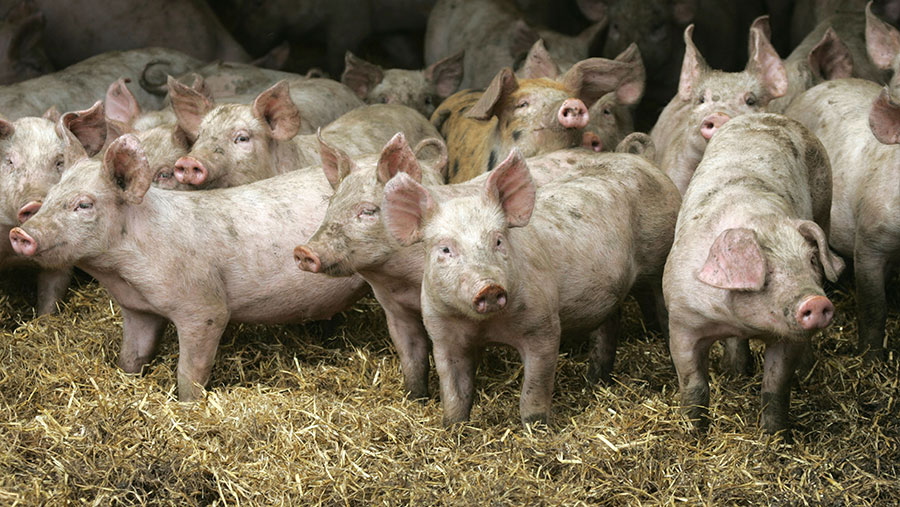Pig sector ‘on knife edge’ as farms consider holding diets
 © Tim Scrivener
© Tim Scrivener Severely reduced processing capacity due to the Covid-19 pandemic has left some pig finishing units dealing with backlogs and feeding lower-energy holding diets to manage supply and avoid hefty penalties.
This has ramped up pressure on the UK pig sector, which has suffered spiralling feed costs, rock-bottom cull sow values and a faltering standard pig price (SPP).
Carcass weights have reached record levels, with farms forced to have pigs on feed for longer. A recent SPP average of 88.24kg was reported, up 3.87kg on the year.
Further concerns are developing about the crisis in Germany, which has lost the Chinese export market due to African swine fever (ASF). An estimated 610,000 pigs are backlogged, and German farmers are losing £50 a pig after a huge price fall.
The industry has left no stone unturned in scenario planning, including discussing the possibility of emergency slaughter to protect animal welfare should the need arise.
See also: Pig producers face losses as costs rise and prices fall
State aid
Northern Irish farmers have been promised state support to offset losses incurred during the two-week closure of Cranswick’s Ballymena site after staff tested positive for Covid-19.
The facility closed in August and was reinstated with a license to export to China last week (24 November) after remote video inspections were undertaken by Chinese officials.
Perfect storm: Higher costs and lower prices
- Soya prices have increased 30-35% this year, leaving ex-store values at about £400/t.
- Feed wheat rose again this autumn, lifting from about £160/t to nearer £190/t.
- A cull sow can normally buy a gilt and sometimes leave some change left over. It is currently taking three sows to buy one gilt and prices are at about 40p/kg.
- Depressed EU prices have left German prime pigs at about £20, adding to fears about more cheap imported pigmeat pressuring the UK price.
Preparation
National Pig Association (NPA) chief executive Zoe Davies said the Cranswick plant at Watton and Pilgrim’s Pride plant at Ashton were still without licences to export to China.
Dr Davies said the threat of ASF in Europe and coronavirus in China had forced some producers to market pigs promptly earlier in the year after being advised to build in “slack” in the supply chain. This contingency planning had stood the industry in good stead, she added.
But she stressed that the pig industry was on a “knife edge”, although it was testament to the whole supply chain that there hadn’t been larger price falls and animal welfare issues.
Last week, the NPA announced it had set up a forum with vets, processors and various Defra departments to discuss Covid-19’s effect on the supply chain.
She said: “We are doing all we can to ensure everybody across the supply chain and in government are aware of the situation and working together to find solutions, particularly looking at worst-case scenario planning should the need arise.
“It’s not something I feel comfortable looking at, but I would much rather we were prepared and had a plan ready to go if needed to avoid a much worse situation on farm.”
Holding diets
Units faced with having contracts rolled over by processors may opt to reduce daily liveweight gains to cut the number of pigs exceeding the limits of the contract if they have capacity.
Holding diets have been formulated for farms looking to limit growth by reducing energy levels and increasing neutral detergent fibre (NDF).
Steve Jagger, senior pig nutritionist at ABN, said pigs being fed lower-energy diets may show increased aggression and competition for food, so pen enrichment may become even more important to minimise issues.
Dr Jagger said holding diets for the final seven to 10 days could be formulated in this way:
- Net energy of the diet would have to drop from roughly 9.3-9.5MJ/kg to about 8.5MJ/kg.
- NDF content would have to increase to about 24% before intakes could be controlled. Typical finishing diets contain about 14-16% NDF.
- A holding diet might work out about £10/t cheaper, but more feed would have to be fed overall, so this could amount to a cost of 5p/kg of liveweight gain, or 50p a pig for every 10kg gained.

